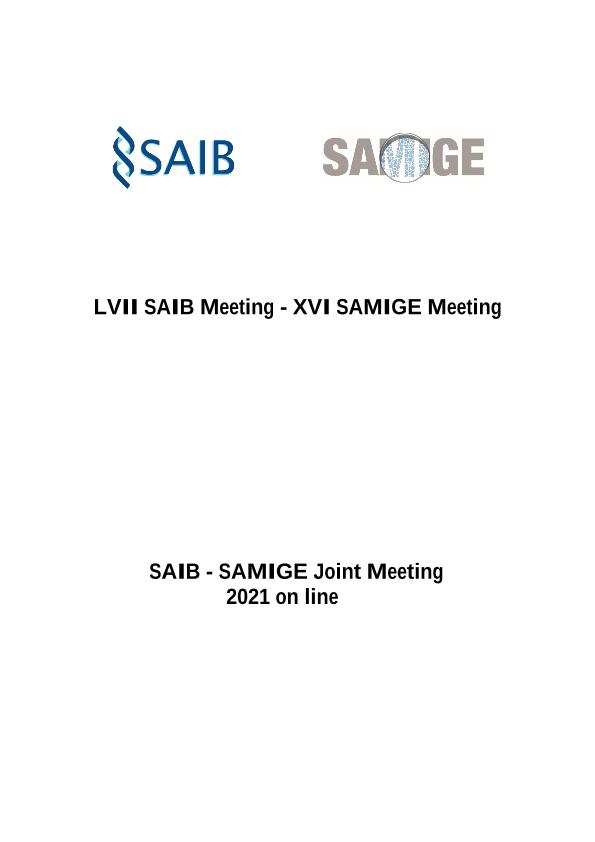Mostrar el registro sencillo del ítem
dc.contributor.author
Toranzo, Araceli

dc.contributor.author
Páez, Paulina Laura

dc.contributor.author
Lucero Estrada, Cecilia Stella Marys

dc.date.available
2023-06-08T10:49:49Z
dc.date.issued
2021
dc.identifier.citation
Biogenic silver nanoparticles affect motility and eradicate the biofilm in yersinia enterocolitica; LVII SAIB Meeting; XVI SAMIGE Meeting; Buenos Aires; Argentina; 2021; 123-123
dc.identifier.issn
0327-9545
dc.identifier.uri
http://hdl.handle.net/11336/199922
dc.description.abstract
Yersinia enterocolitica is a Gram-negative cocobacillus, not sporulated, mobile at 25 °C but immobile at 37 °C. This pathogenic specie is widely distributed in nature and animals, being the pig the main reservoir of pathogenic strains for humans. Y. enterocolitica can cause numerous diseases, usually at gastrointestinal level but various complications can be manifested especially in immunocompromised people, being the cases where antibacterial therapy is needed. Biofilms are communities of microorganisms that grow irreversibly adhered to living or inert substrates, contained in a polymer matrix secreted by themselves. The most important property of the biofilm forms in clinical medicine is the enhanced resistance to antimicrobial agents. The flagellar motility is crucial initially for surface attachment and subsequently for biofilm formation in Y. enterocolitica. In addition, the fliA gene is a regulator gene necessary for the expression of flagella. The objective of this work was to determine if silver nanoparticles (AgNPs) phytosynthesized from the aqueous extract of Bothriochloa laguroides are capable of inhibiting motility modifying the expression of the fliA gene and eradicating mature biofilm of Y. enterocolitica. Two strains were used: Y. enterocolitica 8081 bio/serotype 1B/O:4 and Y. enterocolitica ME110 1A/O:5. The swimming and swarming motility was determined in a culture medium containing 0.3 and 0.6 % p/v of agar respectively, the fliA gene expression was carried out by RT-PCR and the mature biofilm eradication was determined by the crystal violet technique. The swimming and swarming motility was effectively reduced by AgNPs at 7.8 pM in the two tested strains. The decrease in swimming was 90.38 % for Y. enterocolitica 8081 and 74.27 % for Y. enterocolitica ME110, while for swarming it was 79.16 % and 89.28, respectively. Furthermore, AgNPs at 31.25 pM significantly reduce (p<0.05) the expression of the fliA gene in the two Y. enterocolitica strains. In addition, the AgNPs were able to eradicate mature biofilm at a concentration of 500 pM, with an eradication percentage of 99.33 % for Y. enterocolitica 8081 and 92.95 % for Y. enterocolitica ME110. The AgNPs were able to decrease the motility in Y. enterocolitica and to eradicate the mature biofilm, for which they could be used in the future not only to prevent the formation of biofilm but also to eradicate formed biofilms.
dc.format
application/pdf
dc.language.iso
eng
dc.publisher
Tech Science Press

dc.rights
info:eu-repo/semantics/openAccess
dc.rights.uri
https://creativecommons.org/licenses/by-nc-sa/2.5/ar/
dc.subject
SILVER NANOPARTICLES
dc.subject
BIOFILM
dc.subject
YERSINIA ENTEROCOLITA
dc.subject
MOTILITY
dc.subject.classification
Bioquímica y Biología Molecular

dc.subject.classification
Ciencias Biológicas

dc.subject.classification
CIENCIAS NATURALES Y EXACTAS

dc.title
Biogenic silver nanoparticles affect motility and eradicate the biofilm in yersinia enterocolitica
dc.type
info:eu-repo/semantics/publishedVersion
dc.type
info:eu-repo/semantics/conferenceObject
dc.type
info:ar-repo/semantics/documento de conferencia
dc.date.updated
2022-11-09T17:27:17Z
dc.journal.pagination
123-123
dc.journal.pais
Estados Unidos

dc.description.fil
Fil: Toranzo, Araceli. Consejo Nacional de Investigaciones Científicas y Técnicas. Centro Científico Tecnológico Conicet - San Luis. Instituto Multidisciplinario de Investigaciones Biológicas de San Luis. Universidad Nacional de San Luis. Facultad de Ciencias Físico Matemáticas y Naturales. Instituto Multidisciplinario de Investigaciones Biológicas de San Luis; Argentina
dc.description.fil
Fil: Páez, Paulina Laura. Universidad Nacional de Córdoba. Facultad de Ciencias Químicas. Departamento de Farmacia; Argentina. Consejo Nacional de Investigaciones Científicas y Técnicas. Centro Científico Tecnológico Conicet - Córdoba. Unidad de Investigación y Desarrollo en Tecnología Farmacéutica. Universidad Nacional de Córdoba. Facultad de Ciencias Químicas. Unidad de Investigación y Desarrollo en Tecnología Farmacéutica; Argentina
dc.description.fil
Fil: Lucero Estrada, Cecilia Stella Marys. Universidad Nacional de San Luis. Facultad de Química, Bioquímica y Farmacia; Argentina. Consejo Nacional de Investigaciones Científicas y Técnicas. Centro Científico Tecnológico Conicet - San Luis. Instituto Multidisciplinario de Investigaciones Biológicas de San Luis. Universidad Nacional de San Luis. Facultad de Ciencias Físico Matemáticas y Naturales. Instituto Multidisciplinario de Investigaciones Biológicas de San Luis; Argentina
dc.relation.alternativeid
info:eu-repo/semantics/altIdentifier/url/http://www.samige.org.ar/admin/news/files/177-Biocell-Preprint-SAIB-SAMIGE-2021.pdf
dc.conicet.rol
Autor

dc.conicet.rol
Autor

dc.conicet.rol
Autor

dc.coverage
Nacional
dc.type.subtype
Reunión
dc.description.nombreEvento
LVII SAIB Meeting; XVI SAMIGE Meeting
dc.date.evento
2021-11-03
dc.description.ciudadEvento
Buenos Aires
dc.description.paisEvento
Argentina

dc.type.publicacion
Journal
dc.description.institucionOrganizadora
Sociedad Argentina De Investigación Bioquímica Y Biología Molecular
dc.description.institucionOrganizadora
Sociedad Argentina de Microbiología General
dc.source.revista
Biocell

dc.date.eventoHasta
2021-11-04
dc.type
Reunión
Archivos asociados
